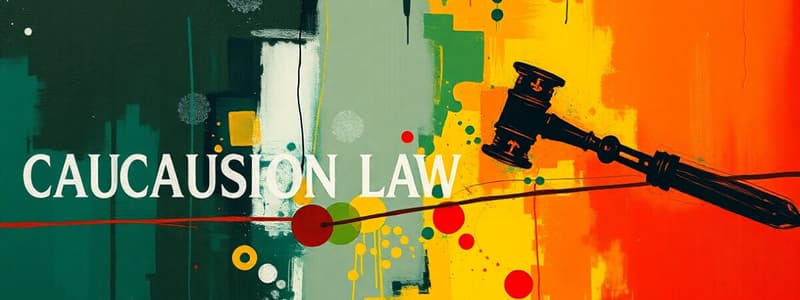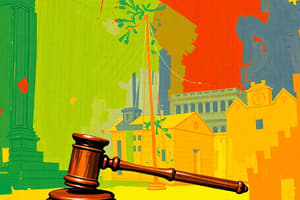Podcast
Questions and Answers
What is the primary focus of causation in law?
What is the primary focus of causation in law?
- To provide automatic compensation for all victims
- To identify negligent actions of the tortfeasor
- To establish the factual cause of harm
- To limit liability based on fairness (correct)
What does the 'But For' test determine in causation cases?
What does the 'But For' test determine in causation cases?
- If the harm would have occurred without the defendant's actions (correct)
- Whether the harm was foreseeable
- The relationship between the victim and the tortfeasor
- The extent of damages that can be compensated
In the case of simultaneous causes, what is the typical resolution?
In the case of simultaneous causes, what is the typical resolution?
- The victim cannot claim damages
- One party is held solely liable
- Both parties are held jointly liable (correct)
- Both parties are found not liable
Which of the following is NOT an example of causation in fact?
Which of the following is NOT an example of causation in fact?
Which doctrine allows multiple parties contributing to harm to be held fully liable for damages?
Which doctrine allows multiple parties contributing to harm to be held fully liable for damages?
What challenge arises when determining causation in events involving loss of chance?
What challenge arises when determining causation in events involving loss of chance?
What key element differentiates causation in fact from causation in law?
What key element differentiates causation in fact from causation in law?
Which statement best describes causation?
Which statement best describes causation?
How does liability assess subsequent causes in an injury case?
How does liability assess subsequent causes in an injury case?
What principle does the 'Thin Skull Rule' illustrate?
What principle does the 'Thin Skull Rule' illustrate?
Which jurisdiction primarily emphasizes foreseeability in legal assessments?
Which jurisdiction primarily emphasizes foreseeability in legal assessments?
What major aspect does liability in tort aim to achieve?
What major aspect does liability in tort aim to achieve?
Which of the following statements is true regarding the 'But For' test?
Which of the following statements is true regarding the 'But For' test?
What is a limitation of the 'But For' test in legal contexts?
What is a limitation of the 'But For' test in legal contexts?
How does 'joint and several liability' function compared to 'several liability'?
How does 'joint and several liability' function compared to 'several liability'?
Which principle is primarily examined by jurisdictions focused on victim compensation?
Which principle is primarily examined by jurisdictions focused on victim compensation?
What does the Thin Skull Rule ensure?
What does the Thin Skull Rule ensure?
What is the main principle used in the UK to limit causation?
What is the main principle used in the UK to limit causation?
In which situation would the Thin Skull Rule apply?
In which situation would the Thin Skull Rule apply?
What is a defining feature of tort law compared to contract and criminal law?
What is a defining feature of tort law compared to contract and criminal law?
What are the five elements required for liability in German tort law?
What are the five elements required for liability in German tort law?
What does causation in fact establish?
What does causation in fact establish?
What is the 'But For' test used for in tort law?
What is the 'But For' test used for in tort law?
What is emphasized in French tort law regarding compensation?
What is emphasized in French tort law regarding compensation?
What must be proven to establish liability in the case of a school accident?
What must be proven to establish liability in the case of a school accident?
What does the court consider when evaluating causation in a school negligence case?
What does the court consider when evaluating causation in a school negligence case?
What does the 'But For' test assess in causation in fact?
What does the 'But For' test assess in causation in fact?
Why could the school's actions be considered negligent regarding supervision?
Why could the school's actions be considered negligent regarding supervision?
Which case exemplifies the principle of remoteness in employer's liability?
Which case exemplifies the principle of remoteness in employer's liability?
What is implied by the 'But For' test in establishing negligence?
What is implied by the 'But For' test in establishing negligence?
What factor would likely prevent the school from successfully arguing contributory negligence?
What factor would likely prevent the school from successfully arguing contributory negligence?
What does the Thin Skull Rule imply regarding employer liability?
What does the Thin Skull Rule imply regarding employer liability?
In which situation would employers in the UK be deemed strictly liable?
In which situation would employers in the UK be deemed strictly liable?
What is one of the inherent risks of allowing unsupervised tasks for students?
What is one of the inherent risks of allowing unsupervised tasks for students?
Which case highlights the duty of care schools have regarding dangerous activities?
Which case highlights the duty of care schools have regarding dangerous activities?
What is an essential component of establishing liability in employer's negligence claims?
What is an essential component of establishing liability in employer's negligence claims?
What does the case Barnett v. Chelsea and Kensington Hospital (1969) illustrate about causation?
What does the case Barnett v. Chelsea and Kensington Hospital (1969) illustrate about causation?
In assessing damages, what constitutes a serious injury in this context?
In assessing damages, what constitutes a serious injury in this context?
What is a key difference between causation in law and causation in fact?
What is a key difference between causation in law and causation in fact?
What legal test do French courts use to determine causation for suicide related to workplace injuries?
What legal test do French courts use to determine causation for suicide related to workplace injuries?
Which of the following factors can make an employer liable for a suicide linked to workplace injuries?
Which of the following factors can make an employer liable for a suicide linked to workplace injuries?
In the context of workplace injuries, what does foreseeability refer to?
In the context of workplace injuries, what does foreseeability refer to?
What might AirLift argue as a potential defense against liability for Mr. Charbonnier's suicide?
What might AirLift argue as a potential defense against liability for Mr. Charbonnier's suicide?
What psychological conditions were highlighted as consequences of Mr. Charbonnier's accident?
What psychological conditions were highlighted as consequences of Mr. Charbonnier's accident?
Which of the following statements regarding the liability of employers for suicides is accurate?
Which of the following statements regarding the liability of employers for suicides is accurate?
What role does the severity of psychological harm play in determining employer liability?
What role does the severity of psychological harm play in determining employer liability?
What precedent in French law relates to employer liability for suicides?
What precedent in French law relates to employer liability for suicides?
Flashcards
Causation in Tort Law
Causation in Tort Law
The link between a tortfeasor's misconduct (negligence) and the harm suffered by the victim. It's not directly defined in law but shaped by case law.
Causation in Fact
Causation in Fact
Examines whether the harm would have occurred 'but for' the defendant's actions. It's about direct causation.
But For Test
But For Test
A test to determine causation in fact. It asks: 'But for the defendant's actions, would the harm have occurred?' If no, there's causation.
Simultaneous Causes
Simultaneous Causes
Signup and view all the flashcards
Loss of Chance
Loss of Chance
Signup and view all the flashcards
Causation in Law
Causation in Law
Signup and view all the flashcards
Joint and Several Liability
Joint and Several Liability
Signup and view all the flashcards
Causation in Law Doctrines
Causation in Law Doctrines
Signup and view all the flashcards
Thin Skull Rule
Thin Skull Rule
Signup and view all the flashcards
Successive Causes
Successive Causes
Signup and view all the flashcards
Limiting Causation
Limiting Causation
Signup and view all the flashcards
What is Tort Law?
What is Tort Law?
Signup and view all the flashcards
What is the "But For" Test?
What is the "But For" Test?
Signup and view all the flashcards
What is the Thin Skull Rule?
What is the Thin Skull Rule?
Signup and view all the flashcards
How does Foreseeability Limit Liability?
How does Foreseeability Limit Liability?
Signup and view all the flashcards
What is Causation in Tort Law?
What is Causation in Tort Law?
Signup and view all the flashcards
What is Causation in Fact?
What is Causation in Fact?
Signup and view all the flashcards
What is Causation in Law?
What is Causation in Law?
Signup and view all the flashcards
How does the UK Approach Tort Law?
How does the UK Approach Tort Law?
Signup and view all the flashcards
Foreseeability
Foreseeability
Signup and view all the flashcards
Remoteness
Remoteness
Signup and view all the flashcards
Strict Liability for Defective Equipment
Strict Liability for Defective Equipment
Signup and view all the flashcards
Intentional Harm in German Employment Law
Intentional Harm in German Employment Law
Signup and view all the flashcards
Breach of Duty in School Supervision
Breach of Duty in School Supervision
Signup and view all the flashcards
Causation in School Negligence Cases
Causation in School Negligence Cases
Signup and view all the flashcards
Damage in School Negligence Cases
Damage in School Negligence Cases
Signup and view all the flashcards
Inherent Risks in School Activities
Inherent Risks in School Activities
Signup and view all the flashcards
But For Test in School Negligence
But For Test in School Negligence
Signup and view all the flashcards
Intervening Acts in School Negligence
Intervening Acts in School Negligence
Signup and view all the flashcards
Contributory Negligence in School Cases
Contributory Negligence in School Cases
Signup and view all the flashcards
School's Potential Liability for Negligence
School's Potential Liability for Negligence
Signup and view all the flashcards
Direct and Certain Link Test
Direct and Certain Link Test
Signup and view all the flashcards
Foreseeability of Suicide
Foreseeability of Suicide
Signup and view all the flashcards
Intervening Act
Intervening Act
Signup and view all the flashcards
Employer Liability for Workplace Harm
Employer Liability for Workplace Harm
Signup and view all the flashcards
Employer Liability for Suicide
Employer Liability for Suicide
Signup and view all the flashcards
Intervening Event
Intervening Event
Signup and view all the flashcards
Precedent
Precedent
Signup and view all the flashcards
Study Notes
Tort Law: Causation
- Definition: Causation is the link between a tortfeasor's actions and the harm suffered by the victim. It's not explicitly defined by statute, but rather developed through case law.
Types of Causation
- Causation in Fact: Examines whether the harm would have occurred "but for" the defendant's actions.
- But For Test: A simplified version of this, asking if the harm would've occurred without the defendant's actions; if no, a causal link exists.
- Example: If a negligent driver causes an accident that leads to injuries, the causation is established if the accident would not have happened without the negligence.
- Causation in Law: Limits liability based on policy considerations and fairness. Ensuring compensation for victims without limitless liability.
- Example: Focuses on controlling liability based on policy considerations, instead of assessing every possible consequence.
Challenges to Causation
- Simultaneous Causes: When multiple parties contribute to one injury, and it's difficult to determine one party's direct contribution, they are held jointly liable (example, two hunters simultaneously firing, simultaneously damaging another party).
- Loss of Chance: Where a defendant's actions reduce the victim's chance of a favourable outcome, even if they didn't directly cause the worsened outcome, causation can be difficult to establish under "but for" test (example, a missed opportunity due to a reckless act).
Causation in Tort Law: Key Doctrines
- Joint and Several Liability: Multiple parties contributing to harm are all held fully liable for the damages.
- Successive Causes: Assessing liability when multiple acts (events) occur sequentially and later worsening damages, where causation analysis focuses on whether the subsequent cause would have produced the same harm.
- Limiting Causation: Jurisdictions employ different principles to limit causation, often focusing on foreseeability to avoid limitless liability
Key Principles to Limit Causation
- Foreseeability: (Adequacy Test) The harm must be typically expected resulting from the defendant's actions.
- Scope of Violation: This focuses on if the harm was within the scope of the violated rule, making sure that the harm is in the reasonable scope of the rule.
- Thin skull rule: A defendant is held responsible for all harm caused by their actions, even if the victim had a pre-existing condition that exacerbated the harm (example, minor accident, pre-existing medical condition worsening the result).
Multiple Choice Questions (with Case References)
- (Further questions and examples are available in the document.)
Studying That Suits You
Use AI to generate personalized quizzes and flashcards to suit your learning preferences.




